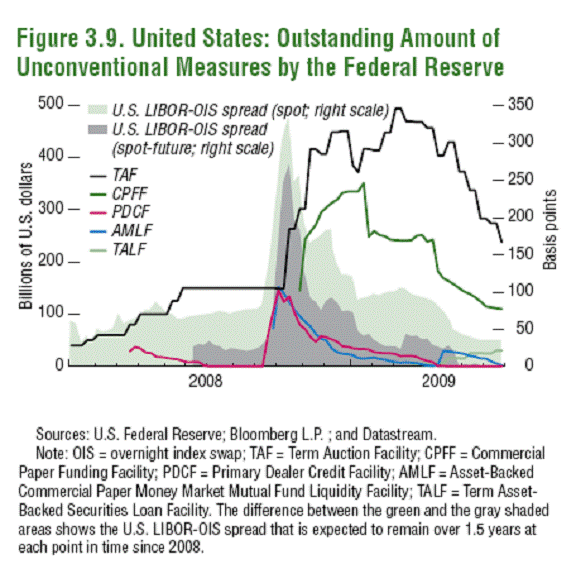Chapters 2 and 3 of the IMF’s Global Financial Stability Report are out.

Figure 3.9 from Chapter 3, IMF GSFR 21 Sep 2009.
Chapters 2 and 3 of the IMF’s Global Financial Stability Report are out.

Figure 3.9 from Chapter 3, IMF GSFR 21 Sep 2009.
One of the most powerful criticisms of increased injections of liquidity to “stimulate” an economy is that such injections constantly require additional injection to have any effect leading to an ultimate inflationary cycle. This can be seen in the John Law period in France, it was obvious in the Assignat inflation that led to the dictatorship of Napoleon, and on and on. Thinking of this consider the following excerpt from chapter 3 of the IMF report.
As the crisis worsened, the announcement
of liquidity support measures no longer had
a direct impact on interest rate spreads. The
knowledge by the markets that central banks
would step in to provide the needed liquidity
translated into a nonsignificant announcement
value.
Is anyone really surprised that additional injections of “stimulus” are required to prop up previous injections?
At least it looks like the IMF has been paying attention. Good job boys.
Chap 3 mentions the Japanese experience, and relative to that time frame we are about 1.5 years thru the 10 years it took for their banking system to become sound again.
We are basically nowhere with resolving the bad debt overhang. The Fed bought a bunch of assets, but now the Fed needs to figure out what to do with them. I think in theory what the Fed buys has to be high rated debt, but we heard how that story goes. Even high quality MBS went from a sub 1% default rate to 9%. Then they loosened up “mark-to-market” rules for banks to make market fluctuations less destructive to balance sheets, but banks are still increasing loan loss provisions.
The chart posted above shows the Fed programs rolling off pretty quickly, but these are the short term funding programs. They don’t show the $1.25 Trillion in MBS, $200B in GSE corps, and $300B in treasuries that the Fed is buying. That adds up to $1.75 Trillion in long term debt. The Fed either has to hold it a very long time, or sell it to mop up excess liquidity whenever that day comes. Or maybe even Fed solvency could be a problem. I always hear that isn’t possible because they have a printing press, but you never know.
So Chap 3 wraps up with a discussion of the possible exit strategy. I still can’t make up my mind if we will need it in 6 months, or 9 years.
Chap 2 is just plain scary. I say keep it simple. Bank CDs and plain vanilla pass thru MBS (with some reasonable underwriting standards) have passed the test of time.
I did come across a synopsis where some economists did a study of the optimal size of the financial sector relative to GDP. They concluded that 8% is about optimal and if it gets any bigger than that, they just cause trouble. If we have a 20% figure and they aren’t even banks really, just sales agents spewing out securitized “products”, we will forever be in deep do-do.
Banks must be derived of ability to play in the “shadow banking system”. If that restriction is not placed on banks they will continue to be attracted to the high returns produced by the non-banks financial system.
I say the non-banks financial system cannot be regulated.
But we can force them to play with money secured from some place other than the regulated banking system.
With this change, big banks will not be threatened with failure and big non-banks can fail without destroying the banking system.
It leaves flaws on derivatives as a mean to short the underlying assets.
Usually a lead manager monitors the information flows (leads and lags)through direct contact with the issuer/borrower How do you cope with this?
Stimuli and public debts are consanguine twin brothers how do you deal with the present state of indebtness?
More debts and deficit matters see hereunder
Budget Deficits, National Saving, and Interest Rates
William G. Gale and Peter R. Orszag
September 2004
Brookings
Reformer Ray,
We need that and more. More Glass-Steagall style firewalls (which is not regulation).
Domestic conventional banking should be a standalone industry with FDIC guarantees for depositors. And while we are at it lets modernize the FDIC insured deposit limit per institution and raise it to a million.
Financial trading should be done by standalone companies should get their funds directly from investors (either equity or direct deposit of investors’ risk funds), not savings account depositors, the Fed, or money markets.
International banking needs to be made separate too. I keep seeing news on CNBC about how Libya is hot, Georgia is hot(not our Georgia) and other places I would care not to hear about. We need to draw the line defining what exactly the US taxpayer may be expected to backstop.
Of course this will never happen, but I can still fantasize.
“We need to draw the line defining what exactly the US taxpayer may be expected to backstop.
Of course this will never happen, but I can still fantasize”.
People like me, who comment on blogs, are accustomed to taking stands that the “establishment” will not consider. That is our proper function.
I fantasize that if enough economists could agree on a point of view (like the one expressed above) and continue to press it unceasingly, the unthinkaable could become reality.